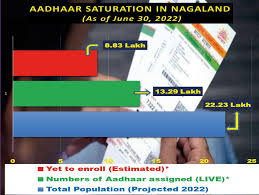Aadhaar is a unique identification number issued by the Indian government, based on biometric and demographic data.
A higher Aadhaar saturation percentage reflects a greater proportion of the population in a region registered under the scheme. Assam has a relatively low Aadhaar saturation of 22.5%, indicating that a large portion of the population has yet to register for an Aadhaar number.
Factors contributing to this include administrative challenges, lack of awareness, outreach difficulties, and infrastructure issues. Assam’s large rural population and remote areas make Aadhaar registration logistically difficult.
A lack of understanding of Aadhaar’s benefits or requirements, particularly in rural or underdeveloped areas, impedes registration. Concerns related to citizenship verification and the NRC (National Register of Citizens) process may have slowed Aadhaar enrollment in Assam.
Aadhaar serves as a crucial tool for accessing government services and benefits, including public welfare schemes, direct benefit transfers, and subsidies. Low Aadhaar saturation in Assam can hinder the effective implementation of these benefits, impacting the state’s development programs.
While Assam lags in Aadhaar saturation, other Indian states and Union Territories have achieved much higher enrollment rates, with near-total Aadhaar coverage in many regions. The low Aadhaar saturation in Assam underscores the challenges in achieving universal enrollment, particularly in rural and remote areas.
Addressing this issue will require increased awareness, improved infrastructure, and targeted outreach programs to ensure more people in Assam can benefit from Aadhaar enrollment.







